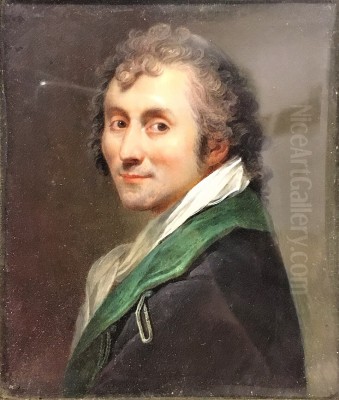
Robert Jacques François Faust Lefèvre (1755–1830) stands as a prominent, if sometimes overshadowed, figure in the constellation of French Neoclassical and early Romantic portraiture. Active during one of the most tumultuous and transformative periods in French history, Lefèvre navigated the shifting tides of political power, from the final years of the Ancien Régime, through the French Revolution, the Napoleonic Empire, and into the Bourbon Restoration. His prolific output, particularly his skillful and often flattering depictions of Europe's elite, cemented his reputation as a sought-after artist, adept at capturing both the likeness and the status of his sitters. While often compared to his more famous contemporaries, Lefèvre carved out a distinct niche, characterized by technical finesse, elegant compositions, and an ability to adapt his style to the prevailing tastes of his powerful patrons.
Early Life and Artistic Formation
Born in Bayeux in 1755, Robert Lefèvre's artistic inclinations emerged early. His initial training was not in the grand academies of Paris but rather under a local painter in Caen. However, the allure of the capital, the epicenter of artistic innovation and patronage in France, proved irresistible. He eventually made his way to Paris, where he sought out the tutelage of Jean-Baptiste Regnault (1754–1829), a significant academic painter and a rival to the great Jacques-Louis David.
Regnault, himself a winner of the prestigious Prix de Rome, instilled in Lefèvre the principles of Neoclassicism: clarity of form, precision of line, smooth finish, and an emphasis on idealized beauty. This was the dominant artistic language of the era, heavily influenced by the rediscovery of classical antiquity and the philosophical currents of the Enlightenment. Lefèvre absorbed these lessons well, developing a refined technique that would serve him throughout his career. His early works, though less documented, would have shown him mastering the academic fundamentals, likely including mythological and historical subjects, which were the traditional proving grounds for ambitious young artists. However, it was in the realm of portraiture that Lefèvre would truly find his calling and achieve lasting recognition.
The Ascent During a Revolutionary Era
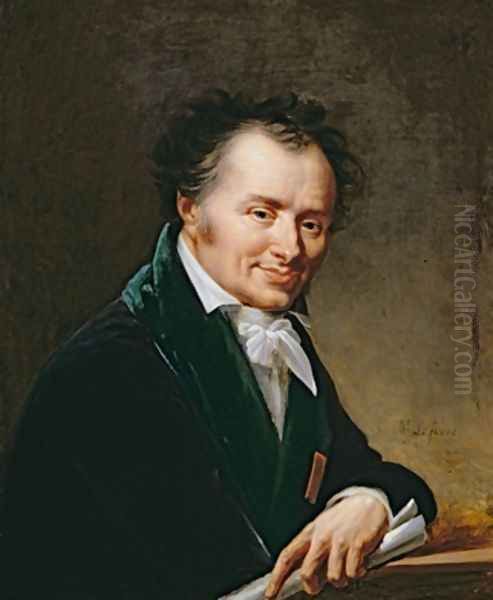
The late 18th century in Paris was a crucible of artistic and political ferment. The French Revolution, beginning in 1789, irrevocably altered the social and artistic landscape. The traditional systems of patronage, largely centered around the monarchy and the aristocracy, were dismantled. Artists like Jacques-Louis David (1748–1825) became key figures in shaping the visual culture of the new Republic, using art as a tool for propaganda and civic instruction.
For a portraitist like Lefèvre, this period presented both challenges and opportunities. While some of his potential patrons were displaced or executed, new figures rose to prominence, eager to have their likenesses immortalized. Lefèvre began exhibiting at the Paris Salon, the official art exhibition, in 1791. This was a critical venue for artists to gain visibility and commissions. His early Salon entries demonstrated his growing skill in capturing character and rendering luxurious fabrics and accoutrements, qualities highly valued in portraiture. He gradually built a reputation for his elegant and sensitive portrayals, attracting a clientele from the newly empowered bourgeoisie and political figures of the Directory and Consulate periods.
Portraitist to the Empire
The rise of Napoleon Bonaparte marked a new golden age for official portraiture, and Robert Lefèvre was perfectly positioned to capitalize on it. Napoleon understood the power of imagery in consolidating his authority and projecting an image of grandeur and stability. Lefèvre became one of the favored portraitists of the Imperial family and the Napoleonic court. His style, which combined Neoclassical precision with a certain softness and an ability to convey an air of dignified elegance, appealed to the Emperor and his circle.
Lefèvre painted numerous portraits of Napoleon himself, in various guises – as First Consul and later as Emperor. One of his most famous depictions is the Portrait of Napoleon I in Coronation Robes (1806), which, while perhaps less iconic than David's or François Gérard's versions, showcases Lefèvre's mastery in rendering the opulent textures of ermine, velvet, and gold embroidery. He also painted Empress Joséphine multiple times, capturing her renowned charm and grace. His portrait of Empress Joséphine (c. 1805-1808, Musée National des Châteaux de Malmaison et Bois-Préau) is a fine example, depicting her with a gentle expression, adorned with pearls and a diadem, embodying imperial elegance.
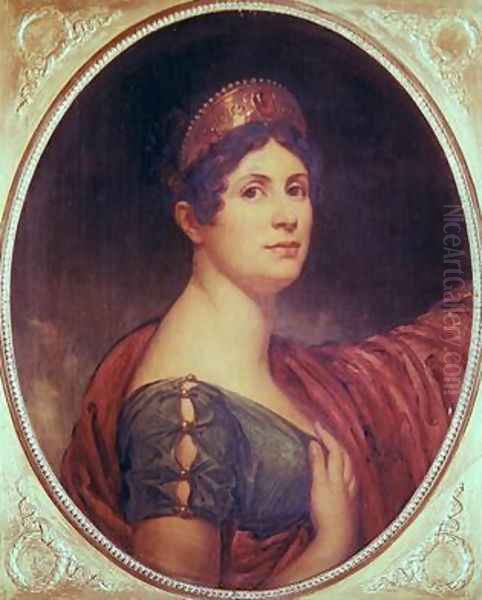
Beyond the Emperor and Empress, Lefèvre's brush immortalized a host of other key figures of the Empire. He painted Napoleon's sisters, such as Pauline Bonaparte, Princess Borghese, renowned for her beauty and vivacity. His Portrait of Pauline Bonaparte, Duchess of Guastalla (c. 1806) is a testament to his ability to capture both individual personality and the fashionable ideals of the era. Marshals, ministers, and court dignitaries all sat for Lefèvre, making his studio a hub of imperial society. His success was such that he was appointed Principal Painter to the Emperor, a testament to his high standing. Other prominent portraitists of this era included Antoine-Jean Gros (1771–1835), known for his dynamic battle scenes and heroic portraits of Napoleon, and Baron François Gérard (1770–1837), a direct rival to Lefèvre in the field of imperial portraiture, also producing numerous iconic images of the Napoleonic elite.
Artistic Style and Technique
Robert Lefèvre's style is firmly rooted in Neoclassicism, yet it possesses distinctive qualities. His drawing is precise and assured, defining forms with clarity. He paid meticulous attention to detail, especially in the rendering of costumes, jewelry, and accessories, which were crucial signifiers of status for his sitters. The surfaces of his paintings are typically smooth and highly finished, with an almost enamel-like quality, a hallmark of academic painting of the period.
Compared to the often stern and heroic classicism of Jacques-Louis David, Lefèvre's portraits frequently exhibit a greater softness and a more approachable, if still idealized, humanity. While David might imbue his sitters with Roman gravitas, Lefèvre often aimed for an air of refined elegance and aristocratic poise. His color palettes are generally rich but controlled, often employing deep reds, blues, and blacks, set off by the gleam of gold or the shimmer of satin. He was particularly adept at capturing the textures of fabrics, a skill that greatly enhanced the luxurious appeal of his portraits.
While not an innovator on the scale of David or later, Jean-Auguste-Dominique Ingres (1780–1867), Lefèvre demonstrated a consistent level of technical excellence and a keen understanding of his patrons' desires. His compositions are typically well-balanced and dignified, often employing conventional portrait formats – three-quarter length or full-length – with sitters posed against simple backgrounds or within opulent interiors that further emphasized their social standing. There's a certain psychological acuity in some of his best works, a subtle suggestion of the sitter's personality beneath the polished veneer of official representation.
Notable Works and Their Significance
Beyond his imperial commissions, Lefèvre produced a wide array of portraits. Several stand out for their artistic merit and historical importance:
Portrait of Pope Pius VII (1805): Painted during the Pope's visit to Paris for Napoleon's coronation, this work captures the pontiff's dignified and somewhat melancholic presence. It stands as an important historical document and a fine example of Lefèvre's ability to handle sitters of the highest ecclesiastical rank. Jacques-Louis David also famously painted Pius VII during this period.
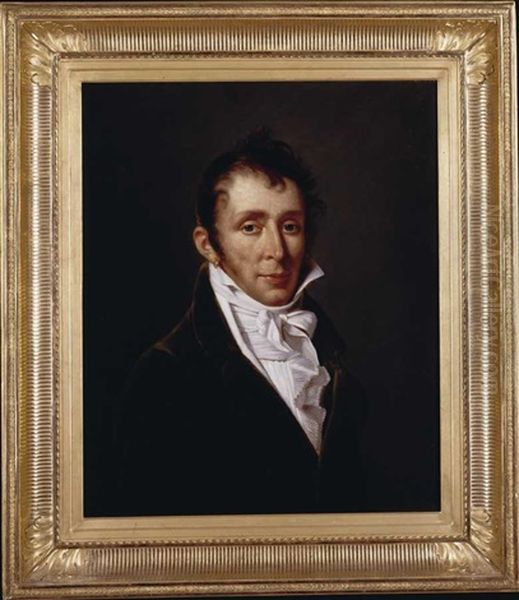
Portrait of Dominique Vivant Denon (c. 1808): Denon was a crucial figure in the Napoleonic art world, the first director of the Musée Napoléon (now the Louvre). Lefèvre's portrait depicts him as a man of culture and authority, surrounded by artifacts, reflecting his role as a connoisseur and administrator of France's artistic treasures.
Portrait of Carle Vernet (1804): Carle Vernet (1758–1836) was a fellow artist, known for his equestrian scenes and battle paintings. Lefèvre's depiction of him is a more intimate portrayal, capturing the character of a colleague within the Parisian art world. Carle's son, Horace Vernet (1789–1863), would also become a highly successful painter.
Portraits of Actors and Actresses: Lefèvre also painted figures from the world of theater, such as the celebrated actress Mademoiselle Raucourt. These portraits often allowed for a greater degree of expressiveness and less formal presentation than his official commissions.
These works, among many others, demonstrate Lefèvre's versatility and his consistent ability to produce high-quality portraits that satisfied the demands of a diverse clientele. His output was prodigious, and his paintings can be found in major museum collections, including the Louvre, Versailles, and numerous regional French museums.
The Bourbon Restoration and Later Career
The fall of Napoleon in 1814-1815 and the subsequent Bourbon Restoration brought another shift in the political landscape. Artists who had been closely associated with the Napoleonic regime faced an uncertain future. However, Lefèvre, ever adaptable, managed to navigate this transition successfully. He had, in fact, painted Louis XVIII in exile even before the Restoration.
Upon Louis XVIII's return to the throne, Lefèvre was appointed Principal Painter to the King, a remarkable continuation of his official status under a new regime. He continued to receive prestigious commissions, painting portraits of the restored Bourbon monarchy and the new aristocracy. His style remained largely consistent, though perhaps with a subtle shift towards a slightly more sober and less overtly heroic presentation, in keeping with the changed political climate. He painted Charles X, who succeeded Louis XVIII, and other members of the royal family.
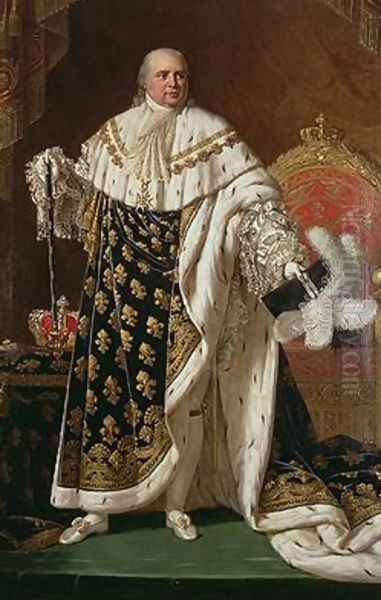
During this later period, the artistic scene in Paris was evolving. While Neoclassicism, particularly in the hands of Ingres, remained a powerful force, Romanticism was gaining momentum, championed by artists like Théodore Géricault (1791–1824) and Eugène Delacroix (1798–1863). Lefèvre's work, while always technically accomplished, remained more aligned with the established Neoclassical tradition, though his sensitivity to character could sometimes hint at the burgeoning Romantic interest in individual emotion. Other notable painters of this transitional period included Pierre-Paul Prud'hon (1758–1823), whose softer, more sensuous style offered an alternative to the sterner classicism of David and his followers, and Anne-Louis Girodet de Roussy-Trioson (1767–1824), a pupil of David whose work often displayed a more pronounced Romantic sensibility. Even earlier prominent female artists like Élisabeth Vigée Le Brun (1755-1842) and Adélaïde Labille-Guiard (1749-1803), though their careers peaked before or during the Revolution, set high standards in portraiture that influenced subsequent generations.
Contemporaries and Artistic Milieu
Robert Lefèvre operated within a vibrant and highly competitive artistic milieu. Paris was the undisputed art capital of Europe, and the Salons were fierce battlegrounds for reputation and commissions.
Jacques-Louis David: The dominant figure of the era. While Lefèvre was not his direct pupil, David's influence was pervasive. David's Neoclassicism was more austere, politically charged, and monumental.
François Gérard: Perhaps Lefèvre's most direct competitor in the field of official and society portraiture. Gérard, a pupil of David, also enjoyed immense success under Napoleon and the Restoration, and their careers often ran in parallel.
Jean-Auguste-Dominique Ingres: A younger contemporary, and another pupil of David. Ingres would become the leading figure of French Neoclassicism in the post-Napoleonic era, known for his exquisite draftsmanship and idealized forms. While Lefèvre's career was well-established by the time Ingres rose to prominence, their paths would have crossed.
Antoine-Jean Gros: Also a pupil of David, Gros specialized in large-scale historical paintings glorifying Napoleon's military campaigns, but he was also a capable portraitist. His style often incorporated more dynamic and Romantic elements than Lefèvre's.
Jean-Baptiste Regnault: Lefèvre's teacher, who maintained a significant academic career and ran a large teaching studio, providing an alternative to David's atelier.
Pierre-Paul Prud'hon: Offered a distinct stylistic alternative with his sfumato technique and more poetic, allegorical subjects, though he also painted portraits.
Anne-Louis Girodet de Roussy-Trioson: Another of David's pupils, whose work often veered towards the exotic and the emotionally charged, prefiguring Romanticism.
Élisabeth Vigée Le Brun: Though her main period of activity in Paris was pre-Revolutionary and during its early years, her elegant and flattering portrait style set a high bar and her influence persisted. She, like Lefèvre, painted many of Europe's royalty.
Adélaïde Labille-Guiard: A contemporary and rival of Vigée Le Brun, also a highly accomplished portraitist and member of the Académie Royale.
Carle Vernet and Horace Vernet: This father and son dynasty specialized in battle scenes, equestrian subjects, and genre paintings, but also engaged in portraiture, representing another facet of the diverse Parisian art world.
Lefèvre's success in such a competitive environment speaks to his skill, his professionalism, and his ability to connect with influential patrons. He was not a revolutionary artist in the mold of David or Delacroix, but he was a consummate master of his craft within the established conventions of his time.
Final Years and Legacy
Robert Lefèvre continued to work and exhibit until late in his life. He died in Paris in 1830, the same year as the July Revolution which brought Louis-Philippe to power, marking yet another political shift. His career spanned over four decades of immense change, and he managed to maintain a high level of success throughout.
His legacy is primarily that of a highly skilled and prolific portraitist who provided a visual record of the French elite during a pivotal period. While perhaps not reaching the absolute first rank of artistic innovators, his contribution to French art is significant. His portraits are valuable historical documents, offering insights into the personalities, fashions, and aspirations of the powerful. Artistically, they represent a refined and elegant strand of Neoclassical portraiture, characterized by technical polish and a keen eye for detail.
In the grand narrative of art history, which often prioritizes radical innovation, artists like Lefèvre can sometimes be overlooked. However, his ability to consistently produce works of high quality, to satisfy the demanding tastes of emperors and kings, and to adapt to changing political fortunes, marks him as a master of his profession. His paintings remain a testament to his skill and an important part of the rich artistic heritage of France. For students of Neoclassicism and the Napoleonic era, Robert Lefèvre's oeuvre offers a wealth of material for understanding the visual culture and social dynamics of his time. He remains a key figure for appreciating the depth and breadth of French portraiture at the turn of the 19th century.